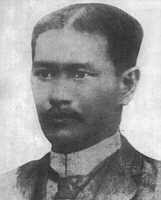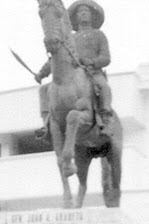A Glimpse of the Confederation of Madya-as
(By DinggolAranetaDivinagracia -IlonggoNationMovement)
Excerpted: "...After partitioning Madyaas into Akean (Aklan and Capiz), Irong-irong (Iloilo) and Hamtic (Antique) to be ruled by Datu Bankaya, Paiburong, and Sumakwel respectively; Datu Putih and the other tribal leaders settled along the banks of the river by the sea with rich, fertile soil and abundant marine products and they called the place "Araut".
Thereafter, the council of elders established the "Katiringban et Madyaas" or the Confederation of Madyaas headed by Datu Sumakwel. This confederated political form of governance preceded great nations in Europe and the Americas, including the USA.
Chinese accounts: To the Chinese, the people of the Confederation of Madyaas were known as the Pisheya. This is a transliteration of the general geographical location of the Confederation of Madyaas, the Visayas islands. This confederation reached its peak under Datu Padojinog. During his reign, the confederations' hegemony extended over most of the islands of Visayas.
In 1612, the Chuan-chou gazeeter specifically reported that the Pisheya consistently made piratical raids against Chinese shipping that impeded Imperial commerce.
Excerpted from: Chronology of the Ancient Chinese Ming Dynasty and Islamic Influences by Ghou Zhongli. "...1433 AD - A Seven-Datu-Council codified the Code of Kalantiaw (by Kalantiaw) and the Maragtas Code (by Sumakwel) for the people of Panay Island; Three Adatus from the original ten who came to Panay left for Batangas and Mindoro; Datu Putih was one of them but eventually returned to North Borneo from where no trace of him was found...."
In Panay, the existence of highly developed and independent principalities of Ogtong (Oton) and Araut (Dumangas) was well known to early Spanish settlers in the Philippines.
The Augustinian historian Gaspar de San Agustin, for example, wrote about the existence of an ancient and illustrious nobility in Araut, in his book Conquistas de las Islas Filipinas (1565–1615).
He said: "También fundó convento el Padre Fray Martin de Rada en Araut- que ahora se llama el convento de Dumangas- con la advocación de nuestro Padre San Agustín...Está fundado este pueblo casi a los fines del río de Halaur, que naciendo en unos altos montes en el centro de esta isla (Panay)...Es el pueblo muy hermoso, ameno y muy lleno de palmares de cocos. Antiguamente era el emporio y corte de la más lucida nobleza de toda aquella isla." Gaspar de San Agustin, O.S.A., Conquistas de las Islas Filipinas (1565-1615), Manuel Merino, O.S.A., ed., Consejo Superior de Investigaciones Cientificas: Madrid 1975, pp. 374-375.
Excerpted from Jose Rizal's essay "The Indolence of the Filipinos" originally written in Spanish and published in La Solidaridad on September 15, 1890 (English translation by Charles Derbyshire)
"..Part Three"...Wherefore, Gaspar de San Agustin says: "Although anciently there were in this town of Dumangas many people, in the course of time they have very greatly diminished because the natives are the best sailors and most skillful rowers on the whole coast, and so the governors in the port of Iloilo take most of the people from this town for the ships that they send abroad..." ~~~
Chinese accounts: To the Chinese, the people of the Confederation of Madyaas were known as the Pisheya. This is a transliteration of the general geographical location of the Confederation of Madyaas, the Visayas islands. This confederation reached its peak under Datu Padojinog. During his reign, the confederations' hegemony extended over most of the islands of Visayas.
In 1612, the Chuan-chou gazeeter specifically reported that the Pisheya consistently made piratical raids against Chinese shipping that impeded Imperial commerce.
Excerpted from: Chronology of the Ancient Chinese Ming Dynasty and Islamic Influences by Ghou Zhongli. "...1433 AD - A Seven-Datu-Council codified the Code of Kalantiaw (by Kalantiaw) and the Maragtas Code (by Sumakwel) for the people of Panay Island; Three Adatus from the original ten who came to Panay left for Batangas and Mindoro; Datu Putih was one of them but eventually returned to North Borneo from where no trace of him was found...."
In Panay, the existence of highly developed and independent principalities of Ogtong (Oton) and Araut (Dumangas) was well known to early Spanish settlers in the Philippines.
The Augustinian historian Gaspar de San Agustin, for example, wrote about the existence of an ancient and illustrious nobility in Araut, in his book Conquistas de las Islas Filipinas (1565–1615).
He said: "También fundó convento el Padre Fray Martin de Rada en Araut- que ahora se llama el convento de Dumangas- con la advocación de nuestro Padre San Agustín...Está fundado este pueblo casi a los fines del río de Halaur, que naciendo en unos altos montes en el centro de esta isla (Panay)...Es el pueblo muy hermoso, ameno y muy lleno de palmares de cocos. Antiguamente era el emporio y corte de la más lucida nobleza de toda aquella isla." Gaspar de San Agustin, O.S.A., Conquistas de las Islas Filipinas (1565-1615), Manuel Merino, O.S.A., ed., Consejo Superior de Investigaciones Cientificas: Madrid 1975, pp. 374-375.
Excerpted from Jose Rizal's essay "The Indolence of the Filipinos" originally written in Spanish and published in La Solidaridad on September 15, 1890 (English translation by Charles Derbyshire)
"..Part Three"...Wherefore, Gaspar de San Agustin says: "Although anciently there were in this town of Dumangas many people, in the course of time they have very greatly diminished because the natives are the best sailors and most skillful rowers on the whole coast, and so the governors in the port of Iloilo take most of the people from this town for the ships that they send abroad..." ~~~




















No comments:
Post a Comment